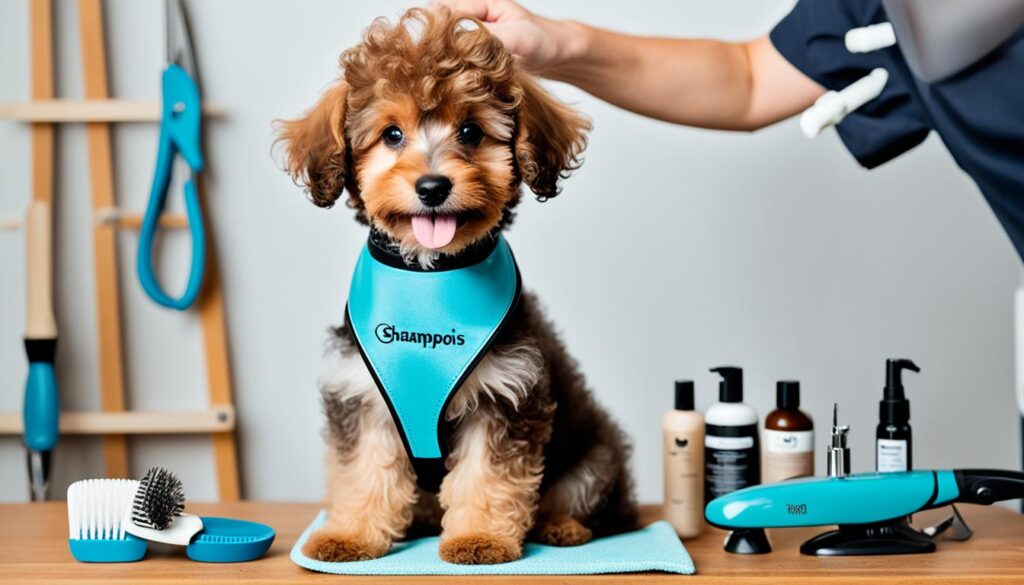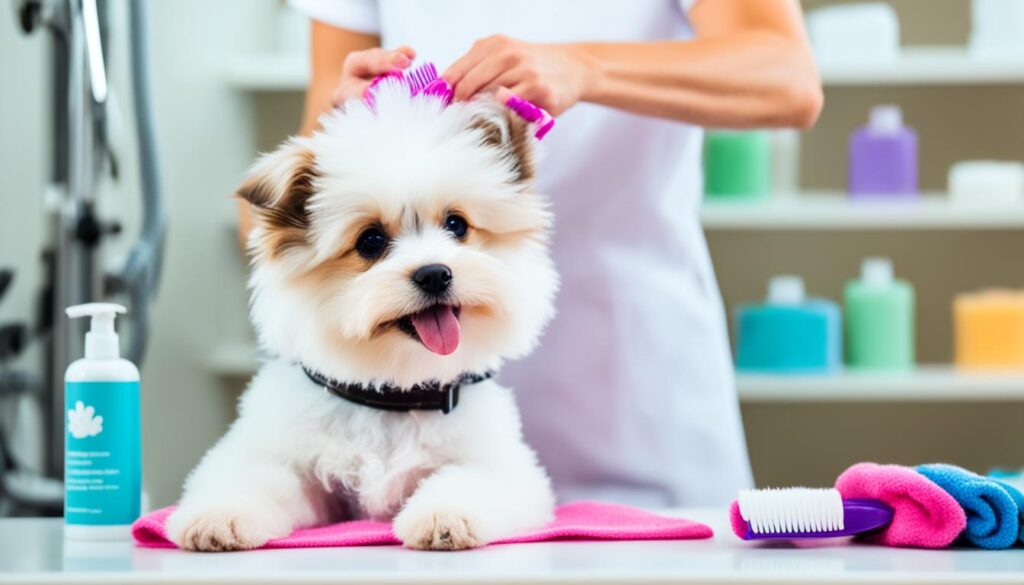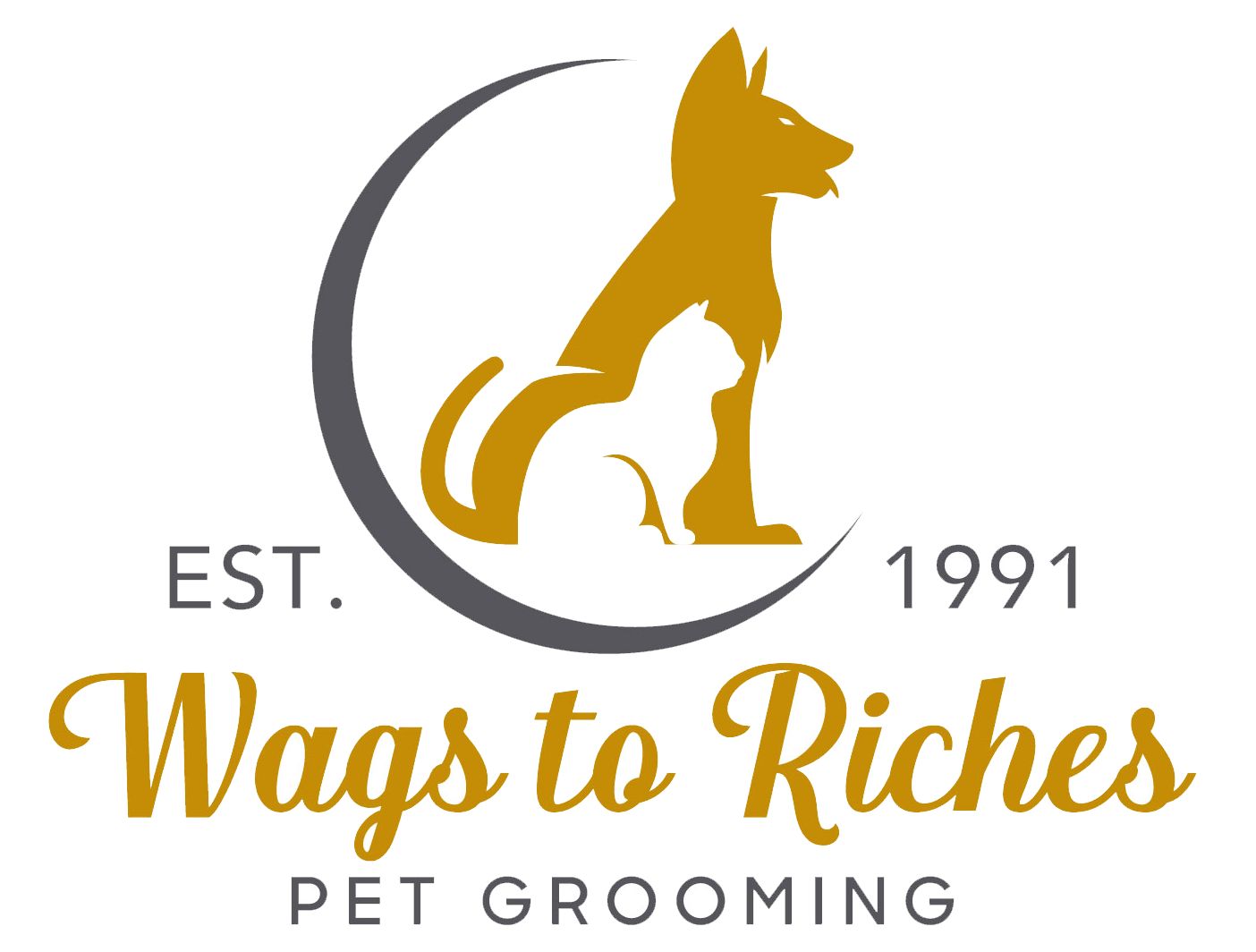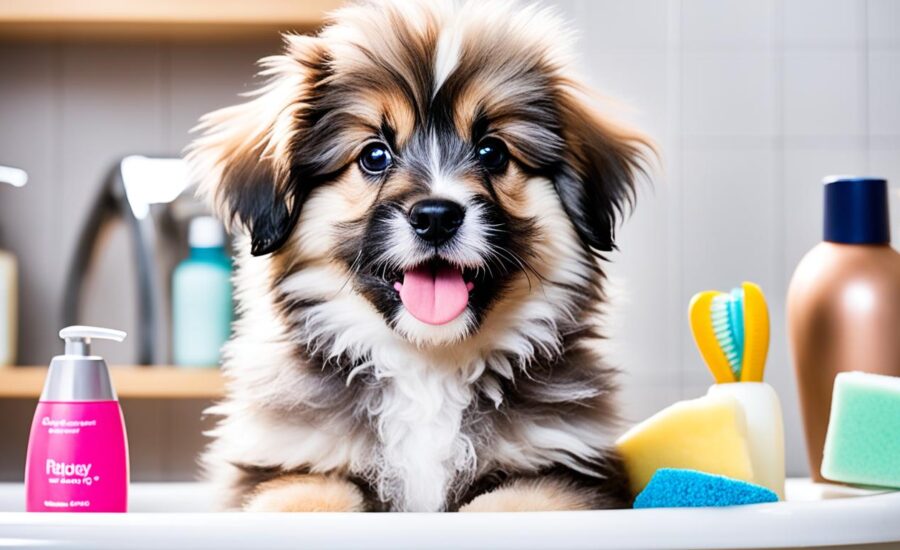Many pet owners strive to find the best care methods for their furry friends. They often miss how crucial regular grooming is for a puppy’s life. Knowing puppy grooming basics is not just about keeping them cute; it’s essential for their health. A grooming schedule for puppies greatly affects their physical and mental well-being.
Learning how to groom a puppy early on sets them up for a lifetime of good habits. Grooming can be a bonding process that benefits both you and your puppy. It supports their comfort and health. More than just a shiny coat, grooming improves skin health, helps with early problem detection, and prevents infections. This shows the importance of a solid grooming base over just giving occasional baths.
This guide will show you how to make puppy grooming a caring routine that keeps your pet healthy and happy. This will also save you from the stress and costs of often seeing professional groomers. With these easy-to-follow techniques, the benefits for your pet are great.
Key Takeaways
- Grasping puppy grooming basics is crucial for your pet’s long-term health.
- Developing a practical grooming schedule for puppies can prevent common health issues and complications.
- Learning how to groom a puppy properly can strengthen the bond and trust between you and your pet.
- Home grooming is a cost-effective alternative that provides safety and comfort for your puppy.
- Using the right tools and practices is key to successful puppy grooming without the need for professional equipment.
- Introducing grooming activities slowly ensures a positive experience for your puppy.
The Importance of Regular Puppy Grooming
A well-groomed puppy is nice to cuddle. Keeping a grooming schedule for puppies is key for their health and happiness. By following a grooming routine, you can check on their health early on. This keeps your fluffy friend in great shape.
Health Benefits of Grooming
Regular grooming stops various health issues. A tangled, matted coat causes discomfort and other problems. A steady grooming schedule for puppies stops skin irritation and helps spot lumps or lesions early. Here’s why it’s beneficial:
- Decreases chances of skin problems
- Finds ticks, fleas, and parasites early
- Stops painful matting and builds up of dirt
- Spot potential health issues early
These grooming habits are key for a healthy pet life.
Bonding Through Grooming
Grooming isn’t just good for health; it strengthens bonds. It’s a special time for pets and owners to connect. Grooming helps puppies trust more, building a deep relationship. Regular sessions make them feel loved and cared for.
This trust impacts how puppies train and adapt, showing grooming’s value in the puppy care guide.
Adding a grooming schedule for puppies to your daily life is not only for looks; it supports their overall well-being. It’s vital for their health and happiness, creating a joyful, well-behaved pup.
Grooming Your Puppy: A Step-by-Step Guide
Getting a new puppy means more than fun and games; grooming is also key to their health. Following a step-by-step guide to grooming your puppy ensures your furry friend stays clean and joyful. Doing it right turns a routine task into fun bonding time.
Start by softly wiping your puppy’s eyes with a moist cloth to stop infections. Be very gentle to keep them comfortable. Move to cleaning their ears with a recommended cleaner and soft materials. It’s important not to poke inside their ears. Then, if their nose is dry, apply a moisturizer to keep it healthy.

Dental care for puppies is crucial, not only for fresh breath but to prevent tooth problems. Add chew toys and quality dental snacks to this routine. Regularly brush and comb their fur, choosing the right tools for their coat type. This is vital to avoid tangles, especially in curly or long-haired breeds.
Grooming your puppy well takes patience and praise as noted in a step-by-step guide to grooming your puppy. Positive experiences will make them enjoy grooming sessions, turning it into quality time.
With time, you’ll become great at grooming. It helps your puppy look and feel good. Thus, each step in this guide enhances your pup’s wellbeing and joy.
Choosing the Right Grooming Tools for Your Puppy
Finding the best grooming tools for puppies is key for their care. There are many tools out there for different puppy coats. It’s important to know which ones to pick to make grooming easier and more effective.
Brushes and Combs Appropriate for Puppy Fur Types
For long-haired breeds, wide-toothed combs and pin brushes are great. They gently untangle hair without hurting the puppy. A slicker brush is good for finer, longer fur. It helps remove loose fur during shedding.
Short-haired puppies do well with bristle or rubber brushes. These brushes take out dead hair and spread oils. This gives their coat a healthy shine.
Essential Puppy Grooming Products
Choosing the right shampoo is important. Look for ones made just for puppies. They should be gentle on their skin and keep the right pH balance. You also need gentle ear cleaners and safe nail clippers or grinders. This keeps their ears clean and their nails short.
| Coat Type | Recommended Brushes/Combs | Additional Grooming Products |
|---|---|---|
| Long-Haired | Wide-toothed Comb, Flexible Slicker Brush | Gentle Puppy Shampoo, Detangling Spray |
| Short-Haired | Bristle Brush, Rubber Brush | Mild Puppy Shampoo, Deshedding Tool |
| Curly/Wooly | Pin Brush, Metal Comb | Hydrating Conditioner, Curl-defining Spray |
| Sensitive Skin | Soft Slicker Brush, Hypoallergenic Cloth | Shampoo for Sensitive Skin, Ear Cleaner |
Remember, always use the right tools for grooming. Good quality grooming tools for puppies make your pet happy and healthy. It also makes grooming more fun for you both.
Establishing a Grooming Routine for Your Puppy
An effective puppy grooming routine is about more than a shiny coat. It’s key for your puppy’s overall health and happiness. Setting up structured grooming routines is important. It can make grooming fun for you and your puppy.
Frequency of Grooming Tasks
Grooming needs change as puppies grow. Here’s a simple guide on how often you should groom your puppy:
| Grooming Task | Frequency |
|---|---|
| Brushing | 2-3 times a week |
| Bathing | Monthly or as needed |
| Nail Trimming | Every 3-4 weeks |
| Ear Cleaning | Every 4 weeks |
| Teeth Brushing | 2-3 times a week |
The right puppy grooming routine depends on several things. These include breed, how active they are, and their personality. Make adjustments as needed. Always ask your vet if you’re unsure about anything.
Creating a Positive Grooming Experience
Making grooming a good experience is key. Here’s how to ensure it:
- Start grooming when your puppy is calm and relaxed.
- Slowly introduce grooming tools. Let your puppy sniff and get used to them.
- Give treats and praise for patience and good behavior during grooming.
- Begin with short sessions, slowly getting longer as your puppy gets used to it.
Being consistent helps a lot. Regular grooming sessions make your puppy comfortable and can even make them look forward to it.

Puppy Grooming Tips for Beginners
Grooming your puppy doesn’t have to be hard. With the right steps and some patience, it becomes a great experience for both of you. Following these puppy grooming tips will help keep your puppy healthy. It also makes your bond stronger. Whether it’s your first time grooming or you want to get better, these suggestions will make grooming easy.
Handling Your Puppy During Grooming Sessions
Start grooming your puppy gently. Begin with short grooming times and slowly increase them. Pay attention to how your puppy feels and calm them with gentle words and pets. Giving treats before and after grooming is a good idea. It makes grooming a happy time for your puppy (and makes it easier for you!).
Dealing with Common Grooming Challenges
Trimming nails, cleaning ears, and brushing teeth are key but can be tricky. Use tools made for puppies, like a special nail clipper or a vet-recommended ear cleaner. If your puppy gets upset, it’s important to stop and give them a break. For active puppies, using a lick mat can help keep them still during grooming.
In the end, remember that being patient, consistently encouraging, and using the right tools will make grooming a special time together. Happy grooming!
FAQ
What are the basics of puppy grooming?
Why is it important to groom your puppy regularly?
Can you give me a step-by-step guide to grooming my puppy?
How do I select the right grooming tools for my puppy?
What are the essential grooming products I need for my puppy?
How often should I groom my puppy?
How can I make grooming a positive experience for my puppy?
What tips do you have for beginners when grooming a puppy?
Source Links
- https://zigzag.dog/en-us/blog/puppy-health/grooming/puppy-grooming-tips/
- https://puppington.co/blogs/pup-wellness/diy-tips-for-at-home-dog-grooming
- https://scratchpay.com/blog/8-steps-to-grooming-a-dog

